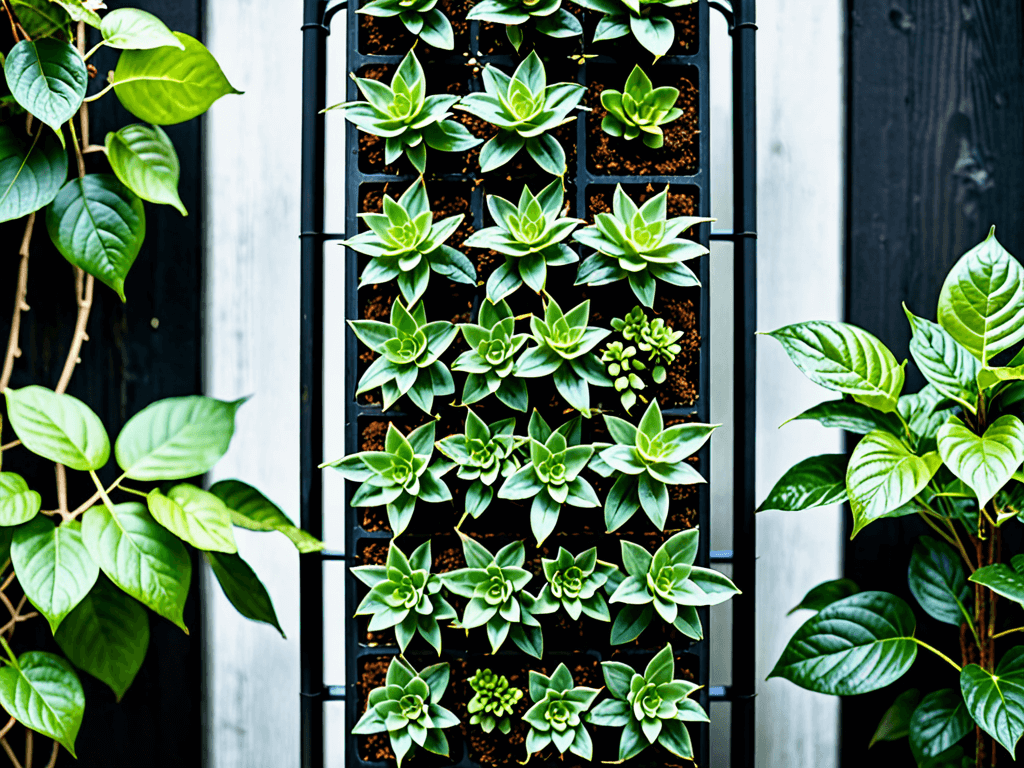Vertical gardening is transforming urban spaces into lush green retreats, allowing enthusiasts to cultivate plants creatively.
By adopting this innovative gardening technique, you can optimize any limited space, bringing nature’s tranquility into your home.
This article covers how vertical gardening works, the benefits it offers, and practical tips to start your very own green masterpiece.
Explore species that thrive vertically, the tools you’ll need, and mistake-proof strategies for maintaining your garden oasis.
Introduction to Vertical Gardening
Vertical gardening introduces a method of growing plants up rather than out, allowing for efficient use of limited space.
This technique is perfect for urban dwellings or any area where horizontal space is scarce.
By utilizing walls, fences, or specially designed structures, one can create a thriving garden even in tight quarters.
Additionally, vertical gardens can enhance the aesthetic appeal of an area, acting as a natural artwork with vibrant colors and textures.
Understanding the basic principles of vertical gardening can help anyone start their own green wall, whether it’s a small indoor setup or a larger outdoor installation.
Benefits of Vertical Gardening
Vertical gardening offers numerous benefits that make it an appealing choice for both urban and rural areas.
By utilizing vertical space, gardeners can grow more plants in a smaller area, which is especially advantageous in densely populated regions.
This method helps in improving air quality by increasing the greenery in a compressed space, effectively filtering pollutants and releasing fresh oxygen.
Additionally, vertical gardens can act as natural insulators, regulating indoor temperatures and potentially reducing energy costs.
They also provide an attractive living wall that can serve as a tranquil oasis amid concrete landscapes, offering mental wellness benefits and a habitat for urban wildlife.
The versatility of vertical gardening allows for a diverse range of plants, from flowers and herbs to vegetables and fruits, making it a sustainable and productive gardening option.
Choosing the Right Plants
Selecting the right plants is crucial for a thriving vertical garden. Consider the light conditions where your garden will be positioned, as different plants have varied sunlight needs.
For sunnier spots, succulents and herbs such as rosemary or basil work well, while ferns and moss are ideal for shadier areas.
It’s also important to select plants based on their growth habits and root systems, as some plants are better suited for vertical growth.
Additionally, think about the climate and whether the plants are suitable for outdoor or indoor settings.
Using a mix of species can enhance visual appeal and biodiversity, making your vertical garden both beautiful and functional.
Essential Tools for Vertical Gardening
Having the right tools is vital for successful vertical gardening. A strong, durable structure or frame is necessary to support your plants, especially in larger setups. You may need freestanding or wall-mounted systems, depending on your space and design.
Quality potting soil is essential to provide the nutrients your plants need, along with a watering system; a drip irrigation setup can be particularly effective to ensure even moisture distribution.
Don’t forget to have on hand basic gardening tools such as trowels and scissors for maintenance, and consider fertilizers that are suitable for the plant types and vertical system you are using to enhance growth.
DIY Vertical Gardening Ideas
Creating your own vertical garden can be an exciting and rewarding project. Start by using simple materials, like old wooden pallets or metal grids, which can be transformed into plant holders.
Consider using recycled containers such as bottles, cans, or fabric pockets to house your plants. These materials can be attached to your chosen structure, creating a cascading effect.
Hanging pots from ceiling hooks or using a series of shelves can also add dimensions to your garden.
Additionally, crafting a vertical herb garden with small pots lined in rows is not only a space-saver but also a great way to have fresh herbs within reach for cooking.
Be creative and use paint and decorations to personalize and give a unique touch to your garden.
Maintaining a Vertical Garden
Maintaining a vertical garden requires regular care to keep plants healthy and thriving.
Checking water levels is crucial, as vertical arrangements can dry out faster than traditional gardens.
Use a drip irrigation system or water each plant manually to ensure consistent moisture.
Regular pruning helps control plant size and encourages growth, while removing dead leaves prevents disease.
Fertilize your plants periodically with suitable nutrients to support their growth.
Inspect your plants for pest infestations regularly, and take action swiftly to control any outbreaks.
By keeping an eye on growth patterns, you can optimize the space, ensuring each plant has enough room to flourish.
Common Mistakes to Avoid
Avoiding common mistakes in vertical gardening can save time and effort.
One frequent error is selecting the wrong plants for the climate or light conditions, which can affect growth.
It’s vital to research and choose plants that will thrive in your specific environment.
Another mistake is overwatering or underwatering; using a moisture meter can help prevent this issue.
Inadequate support can lead to your structure collapsing or plants toppling.
Make sure that the framework and all materials are sturdy enough to hold the full weight of mature plants.
Additionally, neglecting to prune or monitor for pests can lead to unhealthy gardens.
Regular maintenance ensures plants remain healthy and vibrant, enhancing the overall success of your garden.
Inspirational Vertical Garden Designs
Exploring the vast array of inspirational vertical garden designs can spark creativity and ambition.
Consider replicating a living wall art piece, which combines various plants and textures to form a vibrant natural painting.
Incorporating a waterfall feature within your vertical garden can create a stunning visual and auditory experience, while enhancing humidity for the plants.
For a modern touch, integrate LED lights to highlight certain plants or structures at night.
Utilize geometric shapes or symmetrical patterns for a sleek, contemporary design.
Additionally, themed gardens, such as a succulent tower or herb spiral, can not only provide aesthetic appeal but also practical benefits.
In conclusion, vertical gardening is a transformative technique that not only maximizes limited space but also enhances the aesthetic appeal of any environment.
By carefully selecting the right plants, using essential tools, and staying diligent in maintenance, anyone can create a thriving vertical garden.
Avoid common pitfalls by ensuring plants are well-suited to their surroundings and maintain a consistent care routine.
Let your creativity shine with unique design choices that reflect your personal style and make your vertical garden a beautiful focal point.
Embrace the inspiration from various designs to craft a stunning green wall that brings both beauty and tranquility to your space.
FAQ – Frequently Asked Questions about Vertical Gardening
What is vertical gardening?
Vertical gardening involves growing plants on vertical surfaces instead of traditional horizontal gardens, making efficient use of limited space.
What are the benefits of vertical gardening?
Vertical gardening saves space, improves air quality, insulates your home, and can enhance the aesthetic appeal of your surroundings.
What plants are best for vertical gardens?
Choose plants that match your light conditions and climate, like ferns for shade or herbs for sunny spots.
How do I maintain a vertical garden?
Regular watering, pruning, and monitoring for pests are essential for keeping a vertical garden healthy.
Can I use recycled materials for vertical gardening?
Yes, many vertical gardeners use recycled items like pallets or bottles to create sustainable plant holders.
Is vertical gardening suitable for indoors and outdoors?
Yes, vertical gardens can be adapted for both indoor and outdoor environments based on plant selection and design.
What tools are needed for vertical gardening?
Key tools include a strong structure, a watering system, and basic gardening tools like trowels and pruners.


